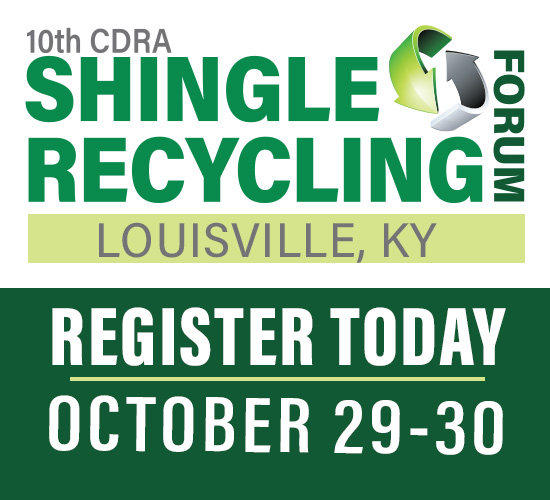To ensure the environmental benefits of recycled materials are properly factored into important policy decisions, CDRA members met with US EPA representatives and commented on the agency’s latest WARM Model revision v16.
The U.S. Environmental Protection Agency’s Waste Reduction (WARM) model, long used to calculate greenhouse gas emissions for materials management, including recycling, was revised in December, and the revision was put out for public comment by mid-March.
As many entities use this simple publicly available tool, it must provide accurate, up-to-date data. However, in recent comments to the EPA on WARM, the CDRA contended that the agency used old and sometimes incomplete data to determine the value of recycling construction materials. To assist the agency, the CDRA provided newer studies on asphalt shingle and drywall recycling while offering to work with EPA in the future on WARM by providing relevant studies, including life cycle analyses (LCAs), as they are developed.
In its comments, CDRA said, “WARM is important because so many entities, including industry, NGOs, and state and local governments, rely on its computations. There is nothing like it. Hence, it needs to be as accurate as possible. However, we have discovered what we believe are flawed outcomes for determining the value of recycling certain construction materials. We appreciate the opportunity to work with the EPA to provide more accurate data. While EPA has data on C&D as recently as 2018, for some of the construction materials, the data used for the WARM model is from 2009. When will new data be brought into the model so it has the best chance of being relevant? And if the current results generated by the program are not accurate, and the agency is aware of this in certain instances, why even put the program out there, at least without a disclaimer that the results should not be used for official and strategic decisions because it could harm beneficial recycling activities?”
The CDRA pointed out that WARM does not properly measure the impact of landfilling material. “Diverting bulk materials such as drywall and shingles by recycling them conserves landfill space, extending our current landfills' life. Municipalities, the primary users of the WARM calculations, are primary stakeholders regarding available landfill space in their community. The impact of losing this space by filling it with recoverable and recyclable material(s) creates an enormous economic impact on stakeholders. It should be a part of the WARM calculation, especially when it means prematurely filling up landfill space, having to transport waste further for disposal, and creating additional GHG-producing landfills.“
Then, the association provided examples and studies that provided more up-to-date information on determining the true value of recycling two important materials: asphalt shingles and drywall. CDRA’s comments closed with, “We appreciate the EPA's dedication to evidence-based decision-making through tools like WARM. Collaborating with stakeholders to integrate gypsum-specific research could strengthen WARM's utility for this waste stream. We would be delighted to share any relevant research with EPA to help make this tool as accurate as possible. Indeed, the CDRA is currently working on developing LCAs for recycled drywall and recycled asphalt shingles. Once completed, we will share it with the agency.”
For more information about the WARM model or CDRA’s legislative and regulatory activities, contact [email protected]





















